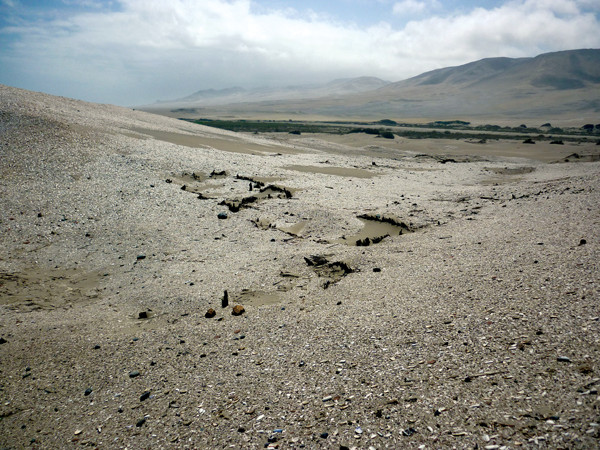
by Lauren Milideo Tuesday, December 9, 2014

An Incan-era shell midden in Peru's Ica Valley. Credit: Matthieu Carré.
Understanding of the El Niño-Southern Oscillation (ENSO) is evolving as scientists unearth new data sources. In a study recently published in Science, scientists turned to the discarded remains of shellfish for a 10,000-year record of eastern Pacific ENSO activity, which offered glimpses into unexpected past ENSO behavior and intensity.
Studying ENSO activity over the past 10,000 years offers indications of how it has operated under diverse climatic conditions and how it may change in the future. Furthermore, researchers say, because it has such far-ranging impacts, the strength and location of ENSO activity are important, interrelated components of understanding and tracking its activity. Yet paleoclimatologists have lacked sufficient means of tracking Holocene ENSO activity in the eastern Pacific, as well as understanding its spatial behavior through time.
One of the most common proxies for past climate and weather patterns is corals, but the coral record in the eastern Pacific is insufficient to study ENSO, lacking fossil corals over the past 10,000 years. So instead, Matthieu Carré, a post-doctoral researcher at the University of Washington at the time of the research who is now at the University of Montpellier in France, and his colleagues turned to shell middens — archaeological deposits of discarded mollusk shells — along Peru’s coast. Taking shell samples from each of seven radiocarbon-dated middens, Carré and his colleagues extracted oxygen isotopes to reconstruct sea-surface temperatures through time. “This is the first time that we have a proxy … of the temperature of the eastern Pacific,” a crucial factor in describing ENSO, Carré says.
The middens accumulated over centuries. Each shell recorded a year or two, but the researchers “have amassed enough of these little snippets of information to be able to say some really powerful and robust things about the evolution of El Niño over this critical time period, the last 10,000 years,” notes Kim Cobb, a paleoclimatologist at Georgia Tech University who was not involved with the study.
The team reconstructed how ENSO changed over the past 10,000 years; large seasonal sea-surface temperature variations reflect stronger, more frequent ENSO intensity. They also used the seasonal temperature variability to assess the spatial aspects of ENSO through the Holocene. High variability in temperatures is associated with the eastern Pacific mode, which relates to stronger eastern ENSO activity; lower temperature variability is associated with the central Pacific mode, which leads to less intense events that occur in the central Pacific.
The team also compared their eastern Pacific record to oxygen isotope records of central Pacific corals and foraminifera near the Galápagos, providing broader spatial coverage of ENSO history and a validation of their results.
The researchers found that, contrary to previous hypotheses, ENSO intensity was closer to recent levels between 10,000 and 6,000 years ago, possibly because of the effects of melting ice sheets. Yet, ENSO was weaker between 5,000 and 4,000 years ago. Furthermore, they uncovered spatial shifts through time, including to the central Pacific mode about 7,500 to 6,700 years ago. “This is actually the first time we really have some hint about the past changes of the spatial structure of ENSO,” Carré says.
The study’s timescale indicates that ENSO is also “sensitive to global climate conditions,” he says. Climate models indicate that without external influence, the ENSO system will maintain changes produced internally only over the course of decades. This study, however, found enduring longer-term variations in ENSO activity, changes that spanned centuries. With a millennial-scale record, Carré says, the patterns observed are “just too long to be internal variability.”
These data provide a starting point for asking “what this system of climate variability responds to, and therefore how our understanding about its future may be improved, or rewritten, or at the very least tested,” Cobb says.
Carré says scientists should take another look at climate models in light of the new findings. “It’s only once the paleoclimate data have been validated … that we can start to compare it with climate simulation,” he says. The models may require adjustment, Cobb adds. “We really have to go back and look at these models in more detail and try to figure out what they’re doing right, what they’re doing wrong, or how our assumptions about El Niño are right or wrong.”
© 2008-2021. All rights reserved. Any copying, redistribution or retransmission of any of the contents of this service without the expressed written permission of the American Geosciences Institute is expressly prohibited. Click here for all copyright requests.